Unisex public toilet
The term unisex public toilets, also called gender-inclusive, gender-neutral and mixed-sex or all-gender toilets, bathrooms or restrooms, refers to public toilets that are not separated by gender or sex. Unisex public toilets can benefit a range of people with or without special needs, for example people with disabilities, the elderly, and anyone who needs the help of someone of another gender or sex. They are also valuable for parents wishing to accompany one or more of their young children needing a toilet facility.
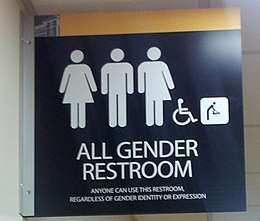
Unisex public toilets take different forms. They may be single occupancy facilities where only one single room or enclosure is provided, or multi-user facilities which are open to all and where users may either share sinks in an open area or each have their own sink in their private cubicle, stall or room. Unisex public toilets may either replace single-sex toilets or may be an addition to single-sex toilets.
Unisex public toilets can be used by people of any sex, gender or gender identity, i.e. male, female, transgender, intersex. Such toilet facilities can benefit transgender populations and people outside of the gender binary. Sex-separation in public toilets (also called sex segregation), as opposed to unisex toilets, is the separation of public toilets into male and female. This separation is sometimes enforced by local laws and building codes. Key differences between male and female public toilets in most western countries include the presence of urinals for men and boys, and sanitary bins for the disposal of menstrual hygiene products for women and girls. Sanitary bins may easily be included in the setup of unisex public toilets.
The historical purposes of sex-separated toilets in the United States and Europe, as well as the timing of their appearance, are disputed amongst scholars. Safety from sexual harassment and privacy were likely two main goals of sex-separation of public toilets, and factors such as morality also played roles.[1]:228, 278, 288–89 Paternalism and resistance to women entering the workplace might have also played a role.[2] Some women's groups are worried that unisex public toilets will be less safe for women than public toilets that are separated by sex. Opposition to unisex public toilets may also be based on morality concerns and discrimination towards transgender people.
Terminology
Several alternative terms are in use for unisex public toilets. Some favor all-gender toilets, gender neutral toilets, gender free toilets or all-user toilets.[3] The "Public Toilet Advocacy Toolkit" by the NGO Public Hygiene Lets Us Stay Human (PHLUSH) in Portland, Oregon (United States) from 2015 uses the term "all-gender".[4] More recently, they have changed to the term "all user".[5] However, some object to the term "gender-neutral" and similar terms, believing that neither the spaces nor the terms are truly neutral. They also object to the replacement of the word "sex" with the word "gender." Such persons often express a preference for the term "mixed-sex."[6] But whatever one calls them, unisex toilets are all toilets which can (in theory) be used by anybody, regardless of sex, gender identity or presentation.[3]
Some of the unisex toilets described herein are "accessible toilets" which are also referred to as "disabled toilets". This term is generally used when talking about a larger than normal toilet cubicle with handrails, enough space for turning a wheelchair, and other features. These toilets usually have a wheelchair-user sign on the outside door.[3]
The opposite of unisex toilets is referred to as either "sex-separated" or "sex-segregated" toilets, or "conventional public toilets" (since sex separation is currently mostly the norm on the global level). In the United States some scholars have used the term “sex separation” and not sex segregation".[1]:229 [2][7][8] “Segregation” is a term that has long been associated with racial segregation in the United States.
Designs
.jpg)
.jpg)
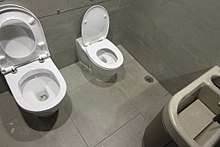
Types
Some unisex public toilets are designed to be used by people with disabilities and have either individual or gender-neutral facilities. They can accommodate people with disabilities, elderly persons who may require assistance from a carer of another gender, or other cases where public sex-segregated facilities might lead to discomfort.[9] Toilet facilities for disabled people, especially those reliant on a wheelchair, may be either unisex or gender-specific.
Unisex public toilets are also common in cases where space is limited, such as in aircraft lavatories and passenger train toilets.
Several types can be distinguished:
- The single occupancy facility where only one single room or enclosure is provided. This room could be used by several people at once, e.g. a whole family, a carer helping a person needing help.
- Multi-user facilities which are open to all and where users may either share sinks in an open area or each have their own sink in their private cubicle, stall or room.
- The re-labelling of existing multi-cubicle public toilets, with no real change. For example, this approach was taken in one area at the Barbican Centre in the UK. Still, the center announced that it would continue to have sex-separated toilets as well.[10]
Toilets
If more than one toilet fixture is available in a unisex public toilet, the toilet seats or squatting pans are installed in enclosed cubicles in the same way as in sex-segregated toilets. To ensure visual privacy, these may be provided with floor-to-ceiling walls.[11]
Sinks
Sinks are commonly installed in open arrangement as in sex-segregated toilets and used collectively by people of all gender.[12][11] Alternatively, a sink can be provided in each cubicle or toilet room, e.g. where the unisex toilet is set up to be used by families and carers.
Urinals
The issue of urinals is creating somewhat of a conundrum for many unisex public toilet designers. In many public toilets, the widespread use of urinals for males means that there are more opportunities to meet their needs. Since urination is a totally natural function, and about 90% of public toilets are used exclusively for this purpose;[13] there are often regular queues in front of female toilets with unused toilet cubicles in the male area. While toilets are usually located in cubicles with lockable doors, urinals are usually installed freely in rows in sex-separated toilet rooms. This construction leads to a smaller space consumption and thus to more possibilities for water-efficient urination, while promoting more sanitary restroom conditions for men/boys at work/school and elsewhere.
Urinals have primarily been offered in public toilets for males, with female urinals being only a niche product so far. Abolishing all urinals would sacrifice resource advantages and convenience for male users, without improving sanitation or wait time for females. Another possibility would be to offer separate male and female urinals or unisex urinals that can be used by males and females alike, which allows increased flexibility of use. Yet this would raise the problem of arrangement. One option would be to continue to offer urinals in rows, with separation by screens. However, it is questionable whether the less private environment, compared to cubicle toilets, would be met with acceptance. Due to socio-cultural conventions, the concept of men/boys urinating with their backs visible to women/girls would possibly create awkwardness for both genders, and would currently seem strange and contrary to common morals and etiquette for many users.
There are even more practical issues for females, such as women/girls needing toilet paper, having to lower their pants, and sometimes tending to their menstrual hygiene needs while going to the toilet for urination. An alternative would be to accommodate urinals for both sexes in cubicles or to continue to offer them only in public toilets for males. However, this would at least limit the above-mentioned advantages of urinals.[14]
Urinals arranged in cubicles have rarely been installed; the advantages over conventional toilets were not obvious because the same space would still be required in the new arrangement. With all things considered, many unisex public toilet designers are now creating plans in which urinals would be constructed in an isolated section or corner of the toilet room, so that they would not be directly visible to anyone in other areas of the public toilet. This is seen by many public toilet designers as the best possible solution that would balance efficiency with modesty.[15]
Building-related advantages
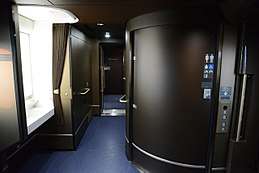
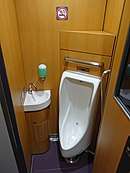
Especially where space is limited, the double design of the sanitary facilities is not possible or only possible to a limited extent. Unisex toilets are often used in many public transport systems, such as rail vehicles or airplanes.
Unisex public toilets are less problematic to use by caretakers of dependents (who include very young children, the elderly, and the mentally and physically disabled) to enter the toilet room together with their charge.[16][17][18]
Women/girls often spend more time in toilet rooms than men/boys, both for physiological and cultural reasons.[19] The requirement to use a cubicle rather than a urinal means that urination takes longer[19] and sanitation is a far greater issue, often requiring more thorough hand washing. Females also make more visits to toilets. Urinary tract infections and incontinence are more common in females.[19] Pregnancy, menstruation, breastfeeding, and diaper-changing increase usage.[19] The elderly, who are disproportionately female, due to men dying earlier in their old age than females, make longer and more frequent toilet visits.[20] Unisex public toilets can alleviate this problem by providing equal sanitation space for all genders, eliminating the prospect of unused cubicles in the male toilets.
Some argue that a two-tier system is also generated via what they called the "toilet apartheid" by excluding women/girls from important social networking processes in male toilets.[21] Important agreements and decisions by men/boys are sometimes made at the urinal where females are currently excluded.[22]
Building-related disadvantages
The consolidation of previously gender-separated toilets or the construction of new unisex toilets is sometimes resisted due to administrative and building law difficulties. Also, where public toilets are located are sometimes dictated by existing plumbing design. If the only way to build unisex public toilets is to locate them in isolated spaces a long way from persons in charge of supervising the space, such a design may be objectionable on safety grounds. Some argue that laws requiring that women and men be treated the same in public toilet access is unfair. Since the 1980s, "potty parity" activists campaigned for laws requiring more female-designated public toilets than male-designated public toilets in public buildings, based on the idea that women require more time to use the toilet and thus women's toilets tend to have longer lines.[23][24][25] California passed the first law of this kind in 1987, and as of 2009 twenty states in the US have passed similar legislation.[23]
Locations


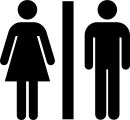
At private companies
Unless otherwise prohibited by law (and when required by law), private companies can provide unisex toilets. In March 2017 Yelp announced that they will add a unisex public toilet finder feature on their app. Yelp was one of over 50 companies that signed a "friend-of-the-court" amicus brief in favor of a transgender high school student Gavin Grimm who claims that his school board denied him access to the boys' toilet in school and thereby violating Title IX. HRC President Chad Griffin stated on the brief that "These companies are sending a powerful message to transgender children and their families that America's leading businesses have their backs."[26][27]
At educational institutions
The Stonewall Centre, an LGBTQ advocacy group, says that certain people feel threatened using facilities that do not adhere to their gender identity, and that this can become an issue when students are harassed by their peers.[28] Advocates argue that forcing trans / non-binary students to use normative gendered public toilets can stigmatize them daily by singling them out.[29] Once again, the response of those opposing such spaces, or opposing them as the norm is safety and privacy for women.
United States
Many colleges and universities (such as Oberlin College in Ohio) have had unisex public toilets as early as 2000. Overwhelmingly, institutions that offer unisex spaces still also offer sex-separated spaces. The University of California at Los Angeles offers more than 160 unisex toilets on campus, but all are single stall.[30] Other collegiate institutions have moved toward creating some unisex public toilets.[31] According to a University of Massachusetts Amherst LGBTQ advocacy organization, The Stonewall Centre, there were more than 150 campuses in the US in 2014 with unisex public toilets.[32]
In February 2016, Michigan was the first state in the US to pass a bill that forces transgender students in public schools to use sanitation facilities that correspond with their 'chromosomes and anatomy' at birth.[33]
The University of Oklahoma continually adds unisex toilets to their campus to accommodate students who may require use of a less excessively gendered public toilet. (Students that fit under this umbrella may identify as non-heterosexual). As of February 2014, the university had 13 unisex toilets.[34] Recently, the university has vowed to include a unisex toilet in all new buildings to be constructed.
There are over 150 college campuses across the US that are creating unisex public toilets, also called "gender-neutral restrooms".[35] In March 2016, New York City private college Cooper Union moved to remove gender designations from campus toilets.[36][37] In October 2016, University of California Berkeley converted several public toilets into unisex toilets.[38]
United Kingdom
In 2015, Scotland aimed to create its first unisex toilet in Strathean Community Campus in Crieff, a secondary school. In 2015, Unisex toilets were set to be introduced into every new school to be built in Scotland in a campaign to eradicate bullying. All future primary and secondary schools will have non-sex-separated toilets. The Scottish Futures Trust which is in charge of Scotland's government's schools building program has already trialed this in one primary school and two secondary schools.[39] In March 2017, the Glasgow City Council announced that toilets in school will no longer be labeled as 'girls' and 'boys' but instead be labelled as unisex to help students who may be struggling with the issue of gender identity. This will be implemented in three schools first.[40]
In the United Kingdom, unisex public toilets are sometimes found on university campuses. In early 2013, Brighton and Hove city council introduced unisex toilets, which did not feature the words 'men/gentlemen' or 'women/ladies' (as is traditional), but instead used 'universal symbols'. Other British universities including Bradford Union, Sussex and Manchester, have already or are in the process of building unisex facilities.[41]
Legislation and country examples
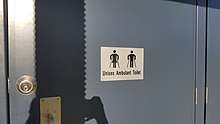
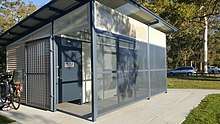
Canada
In April 2014, the Vancouver Park Board decided to install unisex toilets in public buildings, with different signs to identify them. Amongst the options discussed was the rainbow triangle (based on the pink triangle used during the Holocaust), an "all-inclusive" gender symbol, an icon representing a toilet or the phrases "washroom" or "gender-neutral washroom" placed on the entrances to the toilets. According to Global News, a Canadian online newspaper, many different regions across Canada offer unisex toilets and other gender-neutral facilities, but Vancouver was the first municipality to change building codes to require unisex toilets be built in public buildings. This movement, according to commissioner Trevor Loke, was aimed to make everyone feel welcomed and included: "We think that the recommendation of universal washrooms is a good idea [...] [w]e will be using more inclusive language based on the BC Human Rights Code." Some initiatives to make public toilets more diverse and inclusive have focused on language simply by using the phrases "toilet" or "gender-neutral toilet" in order to be inclusive of all genders and gender identities, or using specifically geared language such as "women and trans women" as opposed to just "women" (and vice versa for men and trans men).[42][43]
China
Unisex toilets have appeared in China since before 2013 in Shenyang and Chengdu by 2015. However, it was not until November 19, 2016 that Shanghai China opened its first public unisex toilet near the Zhangjiabin River in a park, in the Pudong district. Many of these toilets have opened in high-traffic areas for the convenience of users as opposed to existing for the benefit of those in need of a unisex toilet, for example sexual minorities or those who are disabled. In May 2016 a Beijing- based non-governmental organization launched an 'All Gender Toilets' campaign to bring awareness to this issue in China. This resulted in around 30 locations opening unisex public toilets.[44]
India
In 2014 the Indian Supreme Court gave transgender people, also known as 'hijras', recognition with a third gender.[45] This legislation included creating separate toilets for transgender people in public spaces where transgender people are often met with violence and hostility.[46][47] The two-judge Supreme Court bench was led by Justice KS Radhakrishnan, who said, "The court order gives legal sanctity to the third gender. The judges said the government must make sure that they have access to medical care and other facilities like separate wards in hospitals and separate toilets".[46] In 2017 The Union Ministry of Drinking Water and Sanitation sent out guidelines to the Swachh Bharat Mission decreeing that members who are part of the transgender community should be allowed to use the public toilet they are most comfortable with.[48]
The central government has allowed transgender persons to use the toilets of their choice in public and community toilets. However, this may not automatically ensure safety from violence.[49]
Japan
As of 2016, no laws were in place regarding the usage of public toilets in relation to gender identity. There may, however, be occasional signs outside public toilets to indicate that the stall is "gender free".[50] The Tokyo city government is planning to install one unisex toilet in at least seven out of eleven of the buildings being used for the Olympic Games in 2020.[51]
Nepal
LGBT rights in Nepal have existed for a number of years but it wasn't until Sunil Babu Pant who was elected into Parliament, used part of the Parliamentarian Development Fund to build the first two unisex toilets in Nepalganj, one of which is in Bageshwori Park.[52] Starting in 2014 The Nepal Country Report, A Participatory Review and Analysis of the Legal and Social Environment for Lesbian, Gay, Bisexual and Transgender (LGBT) Persons and Civil Society recommended that in schools separate toilets or unisex toilets should be built for transgender students.[53]
Thailand
The term "kathoeys" used to describe effeminate male-bodied people, for whom schools have started opening sex-separated toilets for since 2003.[52] After legislation passed, in 2004 a private vocational college in Chiang Mai Thailand gave 15 'kathoey' students the opportunity to use toilet facilities that were solely for them,[54] referred to as 'pink lotus' public toilets.[55] Alliance organizations in Thailand such as the Thai Transgender Alliance and the Transferral Association of Thailand were created to support kathoey people such as by helping create separate public toilet facilities.
United States
There are unisex toilets in some public spaces in the United States. Despite this, transgender and non-conforming gendered people are still sometimes subject to visual or verbal scrutiny; this is reinforced by the architectural design and heteronormative gendered codes of conduct that are still present within the US.[56]
On the federal level, the U.S. Department of Labor is in charge of workplace toilets, which means setting state guidelines through the Occupational Safety and Health Administration (OSHA). For non-work related public toilet guidelines, the Department of Health and Human Services governs regulations.[57] The Equal Employment Opportunity Commission ("EEOC") has also played a role in interpreting federal statutes and enforcing them. Two statutes relevant to public toilets are Title VII (nondiscrimination in the workplace) and Title IX (nondiscrimination in educational opportunity based on sex).
Building codes may be adopted by statute or regulation. They may require sex-separation or they may require unisex toilets. New building codes usually do not apply retroactively. Thus, building owners may choose not to update existing features because it allows them to continue following the older building codes that govern those older features. These regulations are mostly based on the precedent created by original legislation. They sometimes also work to eliminate the longer wait time females often face by creating a ratio of more female toilets than male toilets.[57]
US local ordinances
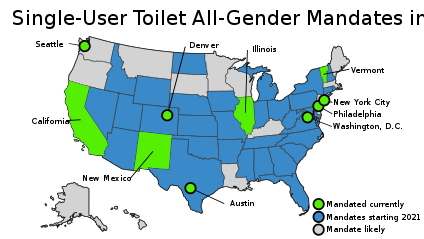
In most jurisdictions, local governments have the ability to pass ordinances, so long as they do not conflict with state law. Cities of San Francisco (CA), Philadelphia (PA), Seattle (WA), Washington (DC), West Hollywood (CA), Austin (TX), Cleveland (OH), New York City (NY), Philadelphia (PA), Washington D.C. and the US states of Vermont, New Mexico, Illinois, and California - have passed measures mandating that single-occupancy toilets in public spaces be labeled as unisex (or gender-neutral).[58][59]
Two examples for local ordinances regarding unisex public toilets (more examples and information is available in bathroom bill):
- The City Council of Portland, Oregon passed an ordinance for "all user restrooms" in 2015. This ordinance directed all city bureaus to convert all "single-user gender-specific restrooms" into "all-user restrooms" within six months.[60]
- On May 11, 2018, the US state of Vermont Gov. Phil Scott signed a bill requiring all single-user public toilets to be unisex - effective from July 1, 2018.[61]
The Human Rights Campaign, an LGBTQ advocacy group, recommends that employers grant access, and use, to public toilets according to an employee's "full time gender presentation", and provides a list of recommendations for employers on how to do so.[62]
History of sex-separated toilets
Theories of historical origins
There are competing theories regarding how and why public toilets (or "bathrooms" in the United States) first became separated by sex in the United States and Europe. Under one theory, offered by Terry Kogan, sex-separation as a standard did not emerge in the U.S. until the late nineteenth century.[2] Under another view, offered by W. Burlette Carter, sex-separation has long been the standard in the U.S. and Great Britain and most of the world where women's well-being was valued.[1] She argues that when people used chamber pots, sex-separation could be achieved by placing the pot in a separated space. In single-use privies and similar spaces, that separation was achieved by allowing only one "sex" to use the space at a time.[1]:295 In multi-use spaces, it was achieved either through the same means or by separate spaces for the sexes. Very likely, the primary reasons for establishing these sex-separated spaces were safety and privacy for women and children.[1] Concerns over undesired pregnancy and procreation were additional considerations. Some of these were related to concerns about rape or about moral views about how and when women should become pregnant (e.g., objections to premarital sex). Evidence also suggest that, in earlier centuries, when people sought to create unisex spaces for those who wanted or needed them, authorities resisted.[1]:263–64
Theories that claim sex-separation was implemented to place women at a disadvantage, may actually harm women because they erase and contort women's history, under a mission of providing relief for other vulnerable groups.[1]:289–90 The same applies to theories that ignore the historical role that sexual harassment and sexual assault have played in women's history. In fact, women's struggles for equality is intricately tied up with efforts to find protection from sexual assault and sexual abuse.[1]:287-290, 258-254 The interpretation of public toilet histories that claim patriarchy and sexism primarily drove sex-separation treat women's negative experiences with sexual harassment as if they did not exist. Such approaches pose a conflict of interest between protecting women and achieving the integration of trans women.[1]:287-290, 258-254
Ancient evidence, including art-work, confirms widespread use of sex-separation (or sex segregation), especially in multi-use spaces - therefore not limiting the concept to public toilets. The exceptions were where the spaces were intended for amorous purposes by opposite sex couples, where safety was considered not to be at risk, or where women were not valued by society.[1]:260–261
It has been claimed that the earliest example of a sex-separated public toilet occurred in Paris (France) in 1739 at a ball.[63] However, another scholar claims that toilet separation by sex preceded 1739, and that in fact sex separated toilets have been a feature in multi-use spaces since their beginnings.[1]:254–267, 292–94
It has been postulated that that the decision to create sex-segregated toilets in the U.S. emerged in the nineteenth century. The theory is that the development was a reflection of women's shift and growth in society, i.e. after women entered the workforce and factories. Massachusetts might have been the first state to pass a law mandating sex-separation in 1887. It was titled "An Act To Secure Proper Sanitary Provisions in Factories and Workshops."[2] The law required establishments to have separate toilets in businesses.[2] The act called for suitable and separate toilets for females in the workplace.[64] Some scholars state that usually there was a room for both sexes and that it was not until the Victorian era, starting in Great Britain, that sex separation began in the toilet area.[65] This might have been an expression of the gender ideology of that era. Prior to the modern industrial period, toilets were apparently frequently communal and mixed. It has been stated that it was only in the nineteenth century, with increasingly strict prohibitions on bodily display and the emergence of a rigid ideology of gender, that visual privacy and the spatial separation of the sexes were introduced into public toilet design.[66]
On the other hand, prior to the 1887 Massachusetts statute, across the United States and Europe at least, sex-separation was the norm already.[1]:258 For example, Massachusetts had statewide regulations that required sex-separation in particular venues such as schools before 1887.[1]:278 Thus, the Massachusetts statute was definitely not the first law mandating sex-separation in Massachusetts.
Safety was likely the key reason for the statutes that began to appear during the Industrial Revolution, although other reasons also may have been used to justify sex-separation. In New York in 1886, for example, factory inspectors asked for separate toilets out of concerns of women who came to them complaining of sexual harassment. Others argued for complete space separation citing the pressure on women to engage in sexual behavior to keep their jobs.[1]:287 Authorities who cared about these issues were trying to respond to those concerns by mandating separation. Indeed, these laws were likely among the first anti-sexual harassment laws in the nation. Many victims in the workplace were afraid to press charges for fear of losing work.[1]:251–52, 287
The earliest written reference to sex-separation in the United States may be from 1786. A traveler described bathers using a public spring called Healing Springs, in South Carolina. The bathers would hang Aprons from a tree to mark when the women were bathing and used Hats to mark when the men were bathing. Within the culture of that time, this practice was tantamount to hanging "women" and "men" signs.[1]:268–69
Primary rationales
One theory argues there were four primary rationales for sex-segregated toilets as detailed by state statutes and related literature in the nineteenth century: sanitation, women's privacy, the protection of women's bodies, which were seen as weaker, and to protect social morality especially as it pertained to the nineteenth century ideology of separate spheres.[2][67][64][7] Subsequently, other states in the US created similar laws, often by amending existing protective labor legislation. Forty-three states had passed similar legislation by 1920.[2] Others argue that safety and privacy were the two main goals of sex-separation, although factors such as morality also played roles.[1]:228, 278, 288–89
Some scholars have tied toilet sex-separation to segregation based on race discrimination in the US.[68] Advocates of this view argue that these approaches share a theme in which a warning is issued against the looming threats: violence and sexual assaults would increase.[22][16][69][68][70] Some political activists have drawn on the commonality between public toilets being segregated formerly by race and still by sex.[71][72] On the other hand, while all discrimination has commonalities, the sex-separation within racial groups, even going back to slavery, suggests that the parallel regarding toilets is historically flawed.[1]:243 For example, slave ships were usually separated by sex.[73] This fact suggests that racial segregation in public toilets and sex separation in them may not be as comparable as some suggest.
Moreover, women of color and poor women were often denied the safety and privacy that sex-separation afforded; white women were given these amenities because they were white. This denial was a sign of discrimination against based on race and/or poverty, a sign of society assigning a lesser value to them as women, and not a sign of advancement or enlightenment. Men also experienced different treatment, not based on class, but based on race, with black men having less favorable facilities.[74] Transgender persons would have been on both sides of these racial lines. There is evidence that when sexual minorities sought to create safe spaces that reimagined sex and gender lines their efforts were resisted.[1]:263–268
Society and culture
Developing countries
In both developed and developing countries, many of the organizations active in water, sanitation and hygiene (WASH) provision have asserted that separate toilets for boys and girls at school are very important to make girls feel comfortable and safe using the sanitation facilities at schools. For example, in 2018, UNESCO stated that single-sex toilets are needed to overcome girls' barriers to education.[75] This concern could potentially apply to boys as well, especially if open urinals are maintained.[76][77][78] As an alternative, some argue that unisex school toilets could be provided at schools in addition to facilities that are separated by gender (which is often the case already in the case of toilets for people with disabilities).
WaterAid is researching options of appropriate unisex public toilets in developing countries. In 2017 they stated that those kinds of gender-neutral/mixed-sex toilets, where people can access all toilets irrespective of their gender, is not recommended in contexts where it may increase the risk of violence against women or transgender people, or where it is deemed culturally inappropriate.[79] Many women, especially those who have been victims of sexual abuse in the past, have asserted the right to continue using all-female toilets to minimize the risk of any kind of sexual harassment in public toilets.
Some activists favor 'third gender' public toilets which would only be used by transgender people. The degree of agreement or disagreement on such issues is difficult to gauge. However, this is still being debated. Some advocates argue that it would reinforce stigma and result in people being banned from accessing the toilets of the gender they identify with.[80][79] It has been argued that in some African countries where transgender people are being prosecuted, this option would likely bring no benefit at all to them.[79]
In the case of India, it has been found that designing transgender-inclusive sanitation is more than just a technical issue: It requires a deeper examination of the role of caste, gender, and age within the transgender community.[49] Using a toilet that explicitly broadcasts a transgender person's identity to others may not be desirable to all transgender persons.[49]
Gender nonconforming persons
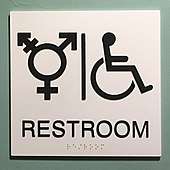
Advocates today say that all-gender public toilets are designed to ensure that toilets are fully accessible to all members of society. They argue that unisex public toilets can eliminate discrimination and harassment for people who may be perceived to be in the "wrong" toilet.[67] Today, many advocates see unisex toilets as an alternative to those separated for boys and girls. Transgender rights advocates have asserted that transgender students should not be forced to use unisex toilets, if that is not what they prefer and should be allowed to use the toilet matching their gender identity. Some argue that they should be not be questioned and required to prove their gender-identity in order to make this choice.
Advocates argue that public toilets and sanitation facilities have historically not met the needs of the LGBTI communities. They argue that this is an issue with respect to the human right to water and sanitation and also from the perspective of the Sustainable Development Goal 6, which aim for universal access to sanitation and their vision of gender equality.[80]
These advocates argue that for many genderqueer people and people of the third sex, such as intersexuals, butch lesbians or people with a non-binary transgender identity, it is difficult or even impossible to go to a sex-separated toilet, as they do not feel that they belong clearly to any sex.[20][81] Sometimes these groups of people are even exposed to hostility when visiting the toilet.
Sex-separation of public toilets began gaining traction as a controversial issue for transgender identity in US politics in 2010. It has been argued that walking into a toilet separated by sex requires people to self-separate and that some transgender people report being challenged on what public toilet they choose to use and subsequently "do their best to forego use of public toilets altogether".[16]
Many questions concerning exactly how social and legal enforcement of the division should take place has been the subject of much debate. Transgender people often face harassment based on their choice in public toilets regardless of whether they use the toilet room corresponding to their gender identity or their sex assigned at birth, which has led many activists in the transgender community to call for legal protection for people wishing to use toilets which most accurately reflect their gender identity. Others have questioned the need for sex-based toilet separation in the first place.
In the 21st century, with increased exposure of the transgender community, there have been some initiatives calling for unisex public toilets, instead of only male and female ones, to better accommodate genderqueer individuals.[82] This has become an increasingly contentious issue, as shown in the battles over North Carolina's Public Facilities Privacy & Security Act 2016. Transgender and gender non-conforming persons also may be subject to embarrassment, harassment, or even assault or arrest by others offended by the presence of a person they interpret as being of a different anatomical sex to themselves.[83] Several groups and organizations, whether in person or online, exist in order to combat the discriminatory attitudes and bills that oppose transgender individuals. For instance, the Transgender Law Center's "Peeing in Peace" is a pamphlet that serves as a resource guide full of information on harassment, safe public toilet campaigns, legal information, and more.[84]
Criticism
Some opponents of unisex public toilets argue that eliminating sex-separation entirely or identifying unisex spaces as the norm is not, in fact, inclusive and that the approach excludes women.[85]
Opponents of unisex public toilets have often referenced concerns that women and children are more likely to be harassed and sexually assaulted there compared to sex-segregated public toilets.[86][87] Safety in public toilets remains a serious issue for women.[88][89] The Me Too movement has underscored that sexual harassment disproportionately affects women and girls and remains a pressing concern for them. The recording of persons in private spaces without their consent (such as installing spy cams) is also an issue.[90][91] Other concerns include that unisex toilets are avoided by women, leading to both discomfort to women and to misuse of the wasted financial funds allocated for the building/remodeling of such toilets.[92]
Supporters of single-sex toilets point to the specific needs of women, such as menstrual hygiene, and argue that these require sex-segregation in public toilets, for reasons of personal comfort and privacy, and this is especially true for teenage girls.[93]
Some women's groups (including some feminist and lesbian groups), have opposed making unisex toilets the norm as well, based on safety concerns for most women and a need for safe spaces.[94][95][96] In the UK, groups like WomansPlaceUK have led a charge to secure "safe" spaces for women, arguing that sexual harassment dangers would be increased for women.[97] They assert that they affirm the existence of transgender people and their right to protection but that women's rights, as they see them, must also be recognized. In this respect, debate has centered around UK proposals to amend the Gender Recognition Act to allow self-identification even for entry into spaces designated for women. Supporters of unisex spaces and access by self-declaration have rejected these claims.[98][99]
A publication in 2018 argued that the scholarship on the history of sex-separation is flawed and places too much emphasis on the negative sides of sex separation in public toilets for women, ignoring aspects of safety for women from sexual harassment. These false narratives should be corrected and there is also a need for more innovative solutions.[1]:289–290 Supporters of sex-segregated toilets argue that unisex toilets can make women feel uncomfortable, and that both males and females may feel "awkward" having to share a toilet with the opposite sex.[100]
Transgender advocates have focused attention on rebutting whether transgender people will attack women.[101] They also focus on the experience of transgender people. By one report, 70% of transgender people report facing harassment or assault while trying to use a public toilet in the District of Columbia.[102]
Some religious groups have opposed unisex public toilets arguing safety and also morality. In 2017, a conservative Christian faith group leader in Texas has compared the introduction of unisex toilets with the abolition of Bible reading in state schools.[103] In Texas there is energy for and against new bathroom bills by various groups of Christians.[103]
In Germany, a member of the German right-wing party Alternative für Deutschland (AfD) regards the unisex toilet as a danger for German women and relates it to sexual assaults by "criminal foreigners".[104]
Protests and opposition
Backlash has sometimes occurred when unisex public toilets have been implemented without wide public embrace. After backlash, and complaints primarily from women, the Barbican Centre in the UK was required to reconsider its original design, which planned gender-neutral toilets.[105] They later issued a statement promising they would keep sex separated toilets as well. In Los Angeles in 2016 there were violent clashes between supporters and opponents of toilets.[106] In Germany, the newly installed unisex toilets at Bielefeld University have repeatedly been vandalized.[107] In the UK, the advocacy group Resisters plastered stickers all over the UK to protest what they called the confiscation of women's spaces. The stickers were in the shape of a penis and stated, "Women Don't Have Penises."[108] A number of local women's groups referred to the behavior as insulting to transgender persons and hate speech.[109]
An event hosted by the advocacy group A Woman's Place UK to discuss and protest changes in the UK's Gender Recognition Act to allow self identification faced a bomb threat in June 2018.[110] They believe such changes would result in women and girls' being denied what they call "safe spaces" and increase women and girls' susceptibility to harassment and violence.[111] Women's Place UK has accused opponents, including those within the UK Labour party of trying to silence women who speak out.[98]
See also
| Wikimedia Commons has media related to Unisex toilet signs. |
- Bathroom bill - legislation about public toilets in the United States
- Female urination device
- Human right to water and sanitation
- Sanitation
- Gender apartheid
References
- Carter, W. Burlette (2018). "Sexism in the 'Bathroom Debates': How Bathrooms Really Became Separated By Sex". Yale Law & Policy Review. 37 (1): 227–297. SSRN 3311184.
- Kogan, Terry (2010). "Sex Separation". In Molotch, Harvey; Norén, Laura (eds.). Toilet: public restrooms and the politics of sharing. New York: NYU Press. pp. 145–164. ISBN 9780814795880.
- Jen, Slater; Jones, Charlotte (2018). "Around the Toilet: a research project report about what makes a safe and accessible toilet space". doi:10.7190/9781843874195. Cite journal requires
|journal=(help) - "Public Toilet Advocacy Toolkit". Public Hygiene Lets Us Stay Human (PHLUSH). Retrieved June 22, 2018.
- "PHLUSH website". Retrieved June 22, 2018.
- "Mixed Sex Toilets in Schools". Womansplaceuk.org. Retrieved January 24, 2019.
- Kogan, Terry (2007). "Sex-Separation in Public Restrooms: Law, Architecture, and Gender". Michigan Journal of Gender and Law. 14: 1–57.
- Robert B. Barnet (1970) The Constitutionality of Sex Separation in School Desegregation Plans, volume 37, Chicago L Review, p. 296
- Devine, Shannon (March 11, 2004). "Inclusive toilets". McGill Reporter. Retrieved February 27, 2009.
- "Statement on Gender Neutral Toilets at the Barbican Centre". barbican.ork.uk. Retrieved January 1, 2019.
- Sanders, J., & Stryker, S. (2016). Stalled: Gender-neutral public bathrooms. South Atlantic Quarterly, 115(4), 779-788 doi:10.1215/00382876-3656191
- Huesmann, M. (2016). Transgressing Gender Binarism in the Workplace? Including Transgender and Intersexuality Perspectives in Organizational Restroom Policies. In Sexual Orientation and Transgender Issues in Organizations (pp. 539-552). Springer, Cham doi:10.1007/978-3-319-29623-4_32
- https://www.map-testing.com/assets/files/female%20urinals.pdf
- Earlywine, Kyle (December 15, 2015). "What Women Think About Urinals". Greenflushrestrooms.com. Retrieved January 28, 2019.
- Scotti, Ariel. "Unisex bathrooms may eliminate long restroom lines for women". nydailynews.com. Retrieved April 29, 2019.
- Case, Mary Anne (2010). "Why Not Abolish the Laws of Urinary Segregation?" (PDF). Toilet: Public Restrooms and the Politics of Sharing. Retrieved April 2, 2016.
- Board, The Editorial (July 27, 2015). "For Transgender Americans, Legal Battles Over Restrooms". The New York Times. Retrieved April 2, 2016.
- Lancaster, Roger. "Imagining the Socialist Bathroom". Jacobin. Retrieved May 21, 2016. Cite journal requires
|journal=(help) - Plaskow, Judith (July 8, 2008). "Embodiment, Elimination, and the Role of Toilets in Struggles for Social Justice". Cross Currents. 58 (1): 51–64. doi:10.1111/j.1939-3881.2008.00004.x.
- Ramster, G.; Greed, C.; Bichard, J. A. (2018). "How Inclusion can Exclude: The Case of Public Toilet Provision for Women" (PDF). Built Environment. 44 (1): 52–76. doi:10.2148/benv.44.1.52.
- Jo Greene: It’s Time To Get Rid Of Gender-Specific Toilets | Thought Catalog In: thoughtcatalog.com
- Kate Wheeling: Stalled Out: How Social Bias Is Segregating America's Bathrooms - The Pacific Standard
- "Social inclusion, toilet rights, and legal protection for transgender Americans". Retrieved March 4, 2017.
- HALL, CARLA (January 14, 2001). "Is 'Potty Parity' Just a Pipe Dream?". Los Angeles Times. ISSN 0458-3035. Retrieved March 4, 2017.
- Bradley, Matt (January 19, 2006). ""Potty parity" aims to remedy long lines". Christian Science Monitor. ISSN 0882-7729. Retrieved March 4, 2017.
- "Yelp to help people find gender-neutral bathrooms". BBC News. March 3, 2017. Retrieved April 25, 2017.
- Dickey, Megan (March 3, 2017). "Yelp is making it possible to find businesses with gender-neutral bathrooms". Techcrunch. Retrieved April 25, 2017.
- Beemyn, Genny. "Gender-Neutral Restrooms" (PDF). umass.edu. Stonewall Center, University of Massachusetts. Retrieved December 20, 2014.
- Bellware, Kim (July 18, 2014). "Gender-Neutral Bathrooms Are Quietly Becoming The New Thing At Colleges". Huffington Post. Retrieved April 27, 2017.
- "UCLA Project to Create More All Gender Restrooms Reaches Milestone". newsroom.ucla.edu.
- Bellware, Kim (July 18, 2014). "Gender-Neutral Bathrooms Are Quietly Becoming The New Thing At Colleges". Huffington Post. Retrieved February 27, 2016.
- Bellware, Kim (July 18, 2014). "Gender-Neutral Bathrooms Are Quietly Becoming The New Thing At Colleges". The Huffington Post. Retrieved December 20, 2014.
- Left, Lisa (February 22, 2016). "The fight over transgender rights in school restrooms intensifies". PBS.
- "Gender-neutral restrooms create a safe place for all people". OUDaily.com. Retrieved October 23, 2015.
- "Gender-Neutral Restrooms" (PDF). University of Massachusetts Stonewall Center. Archived from the original (PDF) on March 19, 2015. Retrieved November 19, 2016.
- "RESTROOM SIGNAGE".
- Redden, Molly (March 29, 2016). "New York college moves to strip gender markings from all bathrooms". The Guardian. Retrieved November 19, 2016.
- "Campus moves forward on gender-inclusive restrooms". October 31, 2016.
- Blackley, Michael (June 21, 2015). "Loo-sing the plot? Now all new schools will have unisex toilets". Mail on Sunday.
- Yorke, Harry (March 6, 2017). "No more separate boys' and girls' toilets at primary schools in Glasgow to help pupils who are 'confused about their gender'". The Daily Telegraph. Retrieved April 22, 2017.
- Cavanagh, Sheila (July–August 2011). "You are where you urinate". The Gay & Lesbian Review Worldwide. 18 (4): 18.
- Judd, Amy (April 29, 2014). "Vancouver Park Board votes to install gender-neutral washrooms". globalnews.ca. Global News. Retrieved December 20, 2014.
- Judd, Amy (March 28, 2014). "Vancouver Park Board asking for input on universal washrooms and signage". globalnews.ca. Global News. Retrieved December 20, 2014.
- "30 Beijing locations embrace China NGO's unisex bathroom campaign". English Sina. June 16, 2016. Retrieved April 19, 2017.
- Mahapatral, Dhananjay (April 15, 2014). "Supreme Court recognizes transgenders as 'third gender'". The Times of India. Retrieved April 28, 2017.
- "India court recognises transgender people as third gender". BBC New. April 15, 2014. Retrieved April 28, 2017.
- ""Unnatural Offenses" Obstacles to Justice in India Based on Sexual Orientation and Gender Identity" (PDF). ICJ. February 2017. Retrieved April 28, 2017.
- Agrawal, Sneha (April 15, 2017). "Transfixed on toilets: India under fire for not creating gender-neutral public washrooms for transgender residents". Daily Mail. Retrieved April 23, 2017.
- Biswas, Durba (May 4, 2019). "Challenges for Transgender-inclusive Sanitation in India". Economic and Political Weekly. 54 (18).
- Crowell, Todd (October 3, 2016). "Why Japanese businesses are embracing the LGBT community". South China Morning Post.
- Jenkins, Aric (March 2, 2017). "Toilets for All Genders Are Coming to the Olympics in Japan". The Times. Retrieved April 27, 2017.
- Knight, Kyle (May 2, 2012). "Nepal Flushes Out Genderism". Huffington Post. Retrieved March 14, 2017.
- "Being LGBT in Asia Nepal Country Report" (PDF). US Aid. 2014. Retrieved April 28, 2017.
- "Thailand: the tale of the pink toilet – transgender rights in Thailand". Out Right Action International. November 3, 2008. Retrieved April 23, 2017.
- Beech, Hannah (July 7, 2008). "Where the 'Ladyboys' Are". Time. Retrieved April 26, 2017.
- Cavanagh, Sheila (2010). Queering Bathrooms: Gender, Sexuality, And the Hygienic Imagination. University of Toronto Press. p. 52. ISBN 978-1-4426-4154-9.
- Brown, Elizabeth (April 11, 2014). "The Biggest Obstacle to Gender Neutral Bathrooms? Building Codes". Reason. Retrieved April 25, 2017.
- Steinmetz, Katy. "The Gender-Neutral Bathroom Revolution Is Growing." Time. January 11, 2016. Retrieved from "The Gender-Neutral Bathroom Revolution is Growing". Archived from the original on December 19, 2016. Retrieved March 22, 2016.
- "California: Unisex restrooms required by new single-stall law". The Mercury News. September 30, 2016. Retrieved October 10, 2017.
- City of Portland, Resolution Number 37175, December 2015
- Ring, Trudy (May 14, 2018). "Vermont Gov. Signs Gender-Neutral Restroom Bill". The Advocate. Retrieved May 17, 2018.
- Human Rights Campaign. "Restroom Access for Transgender Employees." Retrieved from "Restroom Access for Transgender Employees". Archived from the original on December 25, 2016. Retrieved March 22, 2016.
- "The Weird History of Gender-Segregated Bathroomswork=Live Science". Retrieved April 23, 2017.
- Massachusetts (State). Legislature. General Court. 1887 Chap. 0183. An Act to Secure Proper Sanitary Provisions in Factories and Workshops. State Library of Massachusetts. http://archives.lib.state.ma.us/handle/2452/83308
- Anthony, Kathryn H.; Dufresne, Meghan (February 1, 2007). "Potty Parity in Perspective: Gender and Family Issues in Planning and Designing Public Restrooms". Journal of Planning Literature. 21 (3): 267–294. doi:10.1177/0885412206295846. hdl:2142/11713. ISSN 0885-4122.
- Penner, Barbara (2001). "A world of unmentionable suffering: Women's public conveniences in Victorian London". Journal of Design History. 14 (1): 35–51. doi:10.1093/jdh/14.1.35. PMID 20037960.
- Herman, Jody (June 2013). "Gendered Restrooms and Minority Stress: The Public Regulation of Gender and Its Impact on Transgender People's Lives" (PDF). Journal of Public Management & Social Policy. 19 (1). Archived from the original (PDF) on November 22, 2016.
- Frank, Gillian (November 10, 2015). "The Anti-Trans Bathroom Nightmare Has Its Roots in Racial Segregation". Slate. Archived from the original on December 3, 2016.
- "Restroom doors and drinking fountains: Perspective, mobility and the fluid grounds of race and gender" in: Abel, E. (2010). Signs of the times: the visual politics of Jim Crow. Univ of California Press. ISBN 0520261836
- Godfrey, Phoebe (2003). "Bayonets, Brainwashing, and Bathrooms: The Discourse of Race, Gender, and Sexuality in the Desegregation of Little Rock's Central High". The Arkansas Historical Quarterly. 62 (1): 42–67. doi:10.2307/40023302. JSTOR 40023302.
- La Ganga, Maria L (March 30, 2016). "From Jim Crow to transgender ban: the bathroom as battleground for civil rights". The Guardian. Retrieved October 24, 2016.
- Milhiser, Ian (November 6, 2015). "How The Religious Right Learned To Use Bathrooms As A Weapon Against Justice". Think Progress. Retrieved October 24, 2016.
- Campbell, James (2007). Middle Passages: African American Journeys to Africa, 1787-2005. Pengiuin. p. 3. ISBN 978-0143111986.
- Yellin, Eric S. Racism in the Nation's Service: Government Workers and the Color Line in Woodrow Wilson's America. University of North Carolina. pp. 117, 119. ISBN 9781469608020.
- "Single sex toilets 'desperately' needed to overcome girls' barriers to education,' says Unesco". The Independent. March 7, 2018. Retrieved May 27, 2019.
- UNICEF (2012). Raising even more clean hands - Advancing health, learning and equity through WASH in schools. United Nations Children's Fund (UNICEF), New York, USA
- House, S. et al., 2014. Violence, gender & WASH: A practitioner’s toolkit- Making water, sanitation and hygiene safer through improved programming and services. Available at: http://violencewash.lboro.ac.uk/
- Roberts, Rachel (March 21, 2014). "Unisex toilets in schools should be avoided at all costs". independent.co.uk. London: The Independent. Retrieved December 20, 2014.
- Hueso, Andrés; Nath, Priya (July 25, 2017). "Sanitation and gender – looking beyond the binary". WaterAid. Retrieved May 18, 2018.
- Benjamin, C, Hueso, A. (2017) LGBTI and sanitation: what we know and what the gaps are. 40th WEDC International Conference, Loughborough, UK, 2017
- Watkins, P. J., & Moreno, E. (2017). Bathrooms without Borders: Transgender Students Argue Separate is not Equal. The Clearing House: A Journal of Educational Strategies, Issues and Ideas, 90(5-6), 166-171. doi:10.1080/00098655.2017.1361285
- Toilet: Public Restrooms and the Politics of Sharing - Page 192, Laura Noren - 2010
- Rosen, Jill (April 24, 2011). "Victim of McDonald's beating speaks out". Baltimore Sun. Retrieved August 18, 2012.
- "Peeing in Peace: a Resource Guide for Transgender Activists and Allies". San Francisco: Transgender Law Center. 2005. Retrieved January 27, 2019.
- Greed, Clara; Bichard, J. A; Ramster, G (2018). "How Inclusion Can Exclude: The Case of Public Toilet Provision for Women". Built Environment. 44: 52–76. doi:10.2148/benv.44.1.52.
- Menzel, Margie (March 17, 2015). "Moving forward: Transgender bathroom bill passes second Florida House committee". The Miami Herald. Retrieved April 2, 2016.
- Brydum, Sunnivie (March 10, 2015). "Texas Doubles Down on Trans-phobic Legislation, Adding $2,000 Fine for 'Wrong' Bathroom Use". The Advocate. Retrieved April 2, 2016.
- Ellis, Sarah (March 18, 2017). "Suspect in Rape of Elderly Woman Charged". The State. The State. Retrieved January 24, 2019.
- Green, Sarah Jane (May 16, 2018). "Just Sickening: Man Accused of Raping a Woman in the Restroom of Ballard Car Dealership". Seattle Times.
- Froneberger, Laura (January 23, 2019). "Police Announce Additional Charges For Man Caught Illegally Filming in Fairfax County Dressing Rooms". FCPD Media Relations Bureau.
- "Florida Teacher Placed Hidden Cameras Where Students Change Clothes, Deputies Say". WESH2 (Orlando, FL). September 12, 2018.
- Osborne, Simon (August 16, 2018). "What a surprise! Women avoid £40K GENDER NEUTRAL Home Office loos – as too distressing". Express.co.uk. Retrieved May 27, 2019.
- "Unisex toilets put girls at risk of sexual harassment, claims women's rights group". The Independent. February 18, 2019. Retrieved May 27, 2019.
- Brief of the Women's Liberation Front (PDF).
- "Woman's Place UK". womansplaceuk.org. Retrieved January 24, 2019.
- Jeffreys, Sheila (2014). "The Politics of the Toilet". Women's Studies International Forum. 45: 42–51. doi:10.1016/j.wsif.2014.05.003.
- "WomansPlaceUK". Retrieved February 17, 2019.
- "LGBT Labor Witch Hunts". Woman's Place UK. Retrieved January 24, 2019.
- Cavanagh, S. L. (2010). Queering bathrooms: Gender, sexuality, and the hygienic imagination. University of Toronto Press.
- Yorke, Harry (November 27, 2017). "Oxford college votes down calls for gender neutral toilets amid fears it will make students feel 'uncomfortable'". The Telegraph. ISSN 0307-1235. Retrieved May 27, 2019.
- Bianco, Marcie (April 2, 2015). "Statistics Show Exactly How Many Times Trans People Have Attacked You In Restrooms". Mic. Retrieved April 2, 2016.
- Herman, Jody L. (June 2013). "Gendered Restrooms and Minority Stress: The Public Regulation of Gender and its Impact on Transgender People's Lives" (PDF). Journal of Public Management & Social Policy. Retrieved April 2, 2016.
- Transgender 'bathroom bill' leaves Texas Christians deeply divided - The Guardian
- Eine Toilette für alle Geschlechter – wo ist da eigentlich das Problem? - Stern
- Grafton-Green, Patrick (April 6, 2017). "Barbican to Review its Gender Neutral Toilets After Furious Row Breaks Out". London Evening Standard.
- "Students, protesters fight outside LA school with gender-neutral bathroom" In: abc7.com
- Täter zerstören wiederholt Unisex-Toiletten- Immer wieder wird "All Gender"-Toilette an Uni Bielefeld beschädigt - Tag24
- "Hate Speech or Truth: Women Don't Have Penises Stickers Scattered All Over Liverpool Beach". RT. August 21, 2018.
- Pidd, Helen (August 20, 2018). "Sticker Protest on Anthony Gormley's Beach Statues Accused of "Trans Hatred"". The Guardian.
- Huw Oxburgh (June 20, 2018). "Police investigating bomb threat against Hastings meeting". Hastings & St Leonards Observer. Retrieved June 11, 2019.
- Kirkup, James (June 21, 2018). "Why Are Women Who Discuss Gender Getting Bomb Threats". The Spectator.
External links
| Library resources about Unisex public toilet |
- Directory of gender neutral toilets
- Searchable database of family restroom locations
- Queens University – Gender Neutral Washroom Policy
- Canoe.ca – UWO opens transgendered washrooms
- Canada.com – A revo-loo-tion on the UBC campus